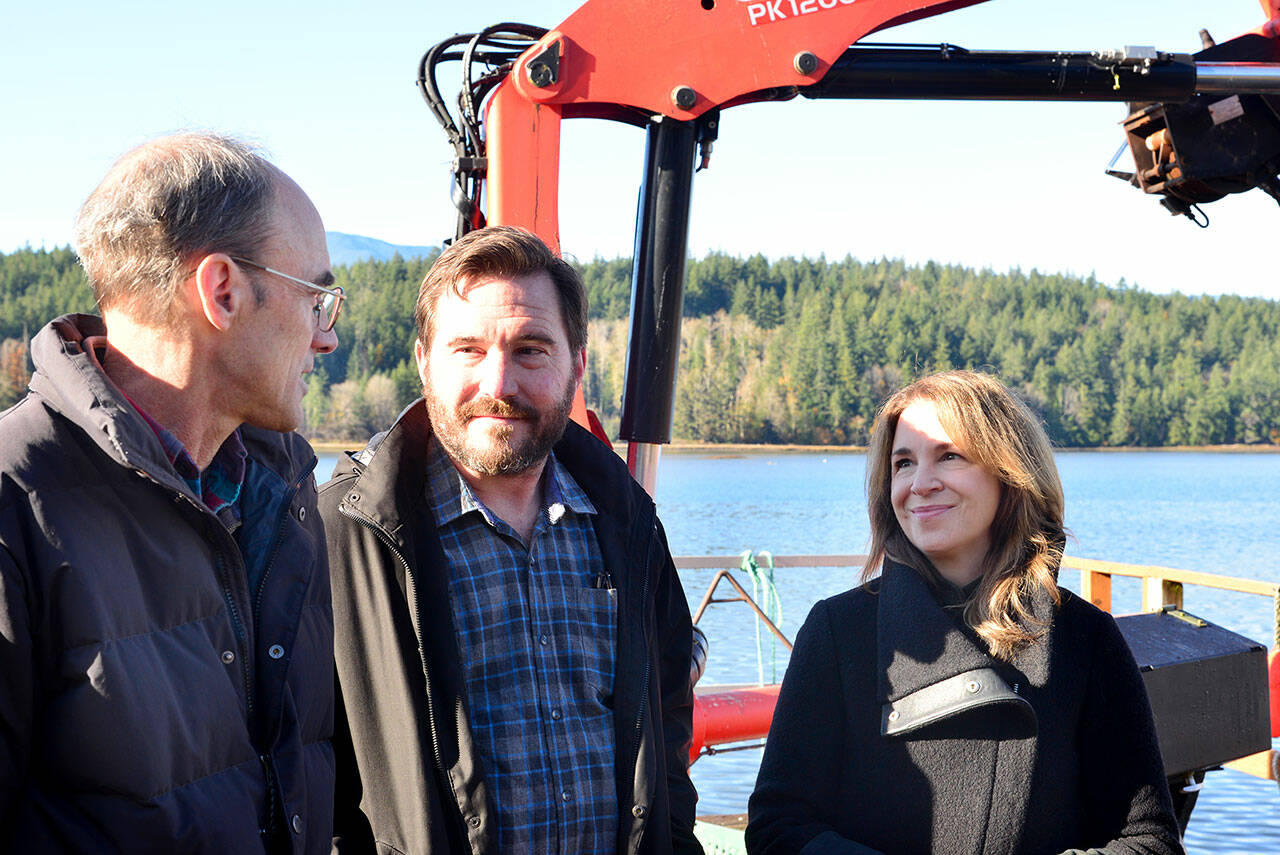DABOB BAY — The state Department of Natural Resources has added another 671 acres to the Dabob Bay Natural Area by moving lands into the state’s new carbon sequestration program as the first of what will ultimately be 2,000 acres in the program, said Commissioner of Public Lands Hilary Franz on Tuesday.
“We’re firm believers that the investments in reducing carbon emissions has to have a natural carbon solution,” Franz said as she stood on the pier of the Rock Point Oyster Company in northern Dabob Bay with Jefferson County Commissioner Greg Brotherton and Peter Bahls, Northwest Watershed Institute executive director.
“Absolutely we’ve got to be investing in transportation because it is our largest greenhouse gas emission, got to make sure we’re doing more clean energy,” Franz said, “but we also need to be investing in our natural solutions, and our trees are our best carbon sequestration, especially on the west side of the state.”
Franz recently changed her plans to run for governor so she could seek the 6th Congressional District now held by Derek Kilmer, a Democrat living in Gig Harbor. Kilmer announced Thursday he would not run again in 2024 for the district that includes the North Olympic Peninsula. Franz, also a Democrat, announced Friday she would run for the Congressional seat and reported several endorsements already made for her.
The Dabob Bay investment was made possible with funds from the state’s Climate Commitment Act (CCA), passed by the state Legislature earlier this year and establishing the nation’s second cap-and-trade carbon program.
Through the program, the state sets limits on the total carbon emissions in Washington with businesses covered by the program required to purchase allowances at quarterly auctions held by the state Department of Ecology.
The first auction was held in February, and in 2023, the program netted the state more than $1.2 billion in proceeds.
One of the requirements of the CCA is that money from the sale of carbon credits be used to purchase additional working forest lands — lands that can be harvested for timber — to offset the lands that are moved into conservation.
DNR manages timber lands for several beneficiaries, including school construction and junior taxing districts, but not all of DNR’s land is readily available for harvest. The forests around Dabob Bay have been said to be home to a rare rhododendron type, and local conservationists have been working to protect the lands for years.
With the expansion of the Natural Area and the funds to buy additional forest lands, Franz called the move a “win-win.”
“Those lands, the 671 acres, are part of a trust. We will now set them aside in conservation,” Franz said. “The money we will use to go buy other working forest land to bring into the trust to keep the beneficiaries whole and also and to be able to protect working forest land.”
Eventually, a full 2,000 acres in Western Washington will be moved into conservation for the carbon sequestration program, and Franz said DNR is in the process of selecting those lands.
One of the requirements of the act is that local counties must support the move, and Franz said Jefferson County had worked closely with DNR to identify the best lands to be placed into conservation.
“We’ve been working really hard to figure out how we can be positive partners and proactive in the protection of the resources and protective of the resource extraction, the oysters and the timber,” Brotherton said.
“We want to create new models that are going to be climate resilient into the new world and mitigate as well. This is just a shining example of that.”
Replacement lands have yet to be selected, and whether or not those new forests would generate as much revenue remains up in the air, Brotherton said, because the forest around Dabob Bay already had some protections on them.
“The goal is that they do not lose any money,” Brotherton said of junior taxing districts. “We were proactive in reaching out to DNR about which land would be really good candidates for (the program), and these, because of the rare forests, would not have been logged anyways. So anything that we can get for the junior taxing districts and the road fund is a win.”
At a meeting in December 2022 to discuss the carbon program, representatives from Jefferson County’s junior taxing districts, including representatives from Jefferson County Fire Protection District No. 2 in Quilcene, expressed concern the move would result in less funding.
Franz, however, was confident DNR would be able to find new working forest lands to replace the acres moved into conservation.
“There’s a lot of land, but we do have to wait for it to be for sale,” Franz said. “We buy and sell land all the time. We’re looking for land that will be well-positioned that will be highly productive working forest land.”
________
Reporter Peter Segall can be reached at peter.segall@peninsuladailynews.com.

